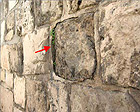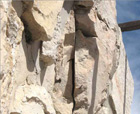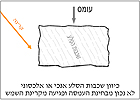|
|
Identifying the Problems and their Causes
2. Stone Deterioration
|

|
Stone deterioration is primarily caused by the seepage of water into the core of the wall, which is a result of faulty sealing or the absence of sealing at the top of the wall. Pointing up the joints with cement-based sealing material along most of the area of the wall has resulted in lateral pressure being exerted from the core to the outside surface of the wall. Therefore the water moves from inside the core of the wall outward via the stones instead of through the joints. This situation has led to accelerated decay of the building stones.
The problem of stone deterioration exists at various levels in most of the regions of the wall. At the time the survey was performed, stone deterioration was not a constructive problem. There are two principal kinds of stone deterioration:
A. Deep weathering in soft limestone
B. Flaking of the outer layers of hard limestone.
Deep weathering in soft limestone. Along with the hard limestone building blocks used in the construction of the wall there is also soft limestone that is highly porous. During the course of the twentieth century the joints between the stones were pointed up with material that is relatively less permeable than the soft limestone. As a result of this the water vapor and the salt emerge from the wall through the soft limestone instead of through the joints and that leads to the disintegration of the stone. This process becomes apparent over time with the deep weathering of the stone (Fig. 17). The deep weathering damages the structure of the stone and its constructive properties and in time is likely to result in the wall becoming unstable.
It is apparent that the deterioration process is in its advanced stages in places where there is more moisture: i.e. beneath cracks, beneath the top of a wall that is not sealed or beneath damaged sealing.
The causes responsible for the deterioration of soft limestone (Fig. 18):
- Water seeping into the wall.
- Joints that are pointed up with cement.
- Vegetation and stagnant water.
- The oxidation of metal parts inside the wall.
- Air pollution.
Flaking of the outer layers of hard limestone. The problem of the outer layers flaking exists on a localized basis in different regions of the wall (Fig. 19). The exterior flaking does not usually damage the structural properties of the stone and will not cause stability problems in the near future.
The causes for flaking: arranging the stones in a manner such that the rock's strata are placed vertically (parallel to the facade of the wall) or diagonally (Fig. 20); burning; extreme temperature change; the stone was originally of a poor quality.
Gluing the flaking layers is a complicated conservation measure that does not prevent further development of the problem. It is therefore recommended that the public be kept away from those areas where the outer layers of stone are flaking in order to prevent injury to passersby.
Identifying the Problems and their Causes > 3. Deterioration of the Bonding Material
|
|

|
| 17. Deep weathering in soft limestone. |

|
| 18. The weathering mechanism of soft limestone due to water seeping into the top of the wall |

|
| 19. Flaking of the outer layers of hard limestone |

|
| 20. Rock’s strata are placed vertically or diagonally |
|
 |
 |
|
|
| Websites, text and photos © Israel Antiquities Authority |
Powered by teti-tu |
|
|















